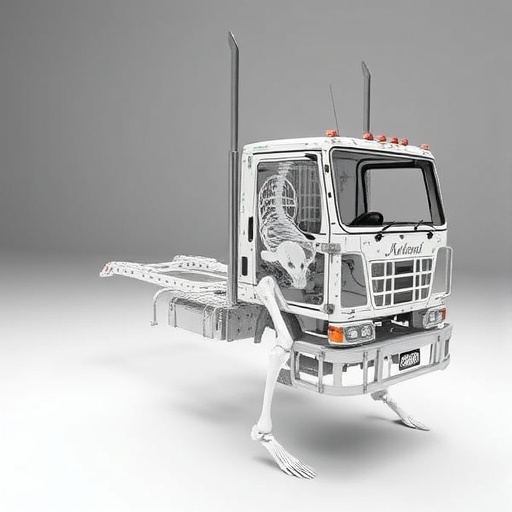In a groundbreaking correction recently published in the International Journal of Legal Medicine, researchers shed new light on the complex skeletal fracture patterns observed in truck occupants involved in fatal motor vehicle incidents. This pivotal study amplifies our understanding of trauma biomechanics, offering critical insights for both forensic medicine and automotive safety engineering. As large vehicles like trucks pose unique challenges given their size, weight, and the forces involved in collisions, this work stands as a crucial advancement in post-accident analysis and reconstruction.
Fatal motor vehicle incidents involving trucks carry an alarming rate of severe injuries, largely due to the mass and momentum that these vehicles command. Unlike passenger cars, trucks have a fundamentally different structure and internal environment, resulting in distinctive injury mechanisms. The corrected research paper dives deeply into these patterns by meticulously examining numerous autopsy reports and crash investigations. The goal is to discern recognizable, reproducible fracture patterns that may be pivotal in understanding the mechanics behind occupant injuries in such catastrophic crashes.
Delving into the technical aspects, skeletal fractures are influenced by various factors including impact velocity, angle of collision, occupant positioning, and protective systems in place — if any. The researchers utilized a combination of retrospective data analysis and biomechanical modeling, integrating high-resolution imaging and quantitative fracture mapping. This approach allowed for detailed characterization of patterns such as comminuted fractures, linear breaks, and complex multi-fragmentary breaks predominantly affecting long bones and axial skeleton components.
One of the notable revelations from the study was the prevalence of distinct thoracic cage injuries. Rib fractures, often underestimated in their forensic significance, were found to cluster in specific regions correlating strongly with truck interior configurations and collision dynamics. These patterns can be instrumental in not only determining the nature of forces at play but also in reconstructing the sequence of trauma, a critical factor in forensic casework and improving vehicle safety features.
Furthermore, the research highlights subtle but consequential differences between frontal and side-impact collisions. Frontal crashes frequently resulted in high-energy fractures of lower extremities, pelvis, and lumbar vertebrae, indicating a direct force transmission from the vehicle structure to the occupant’s skeletal framework. Contrastingly, side impacts led to more complex rib cage and clavicular injuries, underscoring the lateral vulnerabilities of truck cabins and highlighting the need for enhanced side-impact protective designs.
The multidisciplinary team behind this correction also addressed limitations found in their initial publication, providing clarifications on data stratifications and injury classifications. This rigor ensures that future forensic investigations can adopt standardized criteria when evaluating truck occupant injuries. Such harmonization is vital for improving mortality analysis, facilitating legal proceedings, and optimizing preventative strategies.
Importantly, the study places a strong emphasis on the biomechanical interplay between occupant kinematics and vehicle deformation patterns. Advanced computational modeling, coupled with crash test data, permitted a dynamic visualization of how forces propagate through the truck cabin during different collision scenarios. This enabled the authors to hypothesize specific fracture initiation points and propagation pathways within the human skeleton, opening new avenues for injury prediction and mitigation.
The relevance of this research extends beyond the forensic community. Automotive manufacturers and safety regulators stand to gain crucial knowledge about the failure points within truck occupant compartments. This could drive innovation in protective materials, structural reinforcements, and restraint systems, ultimately aiming to reduce fatalities and serious injuries. The study’s insights into skeletal trauma mechanisms highlight the urgent necessity for holistic safety approaches tailored specifically to heavy vehicle impacts.
Moreover, the correction acknowledges the role of occupant factors like age, bone density, and pre-existing health conditions, which modulate fracture susceptibility. Incorporating such biological variables enriches the predictive capability of biomechanical models and refines forensic interpretations. This personalized consideration aligns with broader trends in injury biomechanics emphasizing human variability in trauma outcomes.
Technically, the research draws from a rich dataset of forensic autopsy cases where detailed skeletal assessments were complemented by scene and vehicular data. Such comprehensive case integration exemplifies best practices in forensic research, bridging the gap between pathophysiology and crash dynamics. The sophisticated analytic techniques deployed set new benchmarks for future studies focusing on occupant injury biomechanics in heavy vehicle accidents.
Another crucial discussion point raised concerns the potential implications for emergency medical response. Recognizing characteristic fracture patterns specific to truck crashes could improve triage protocols and treatment prioritization at trauma centers. By anticipating typical trauma profiles, medical teams can tailor diagnostic imaging and intervention strategies, thereby potentially enhancing survivor outcomes.
Additionally, the corrected article underscores the importance of collaborative multi-agency approaches involving forensic experts, engineers, medical practitioners, and law enforcement. Such cooperation enriches investigations and expedites justice in cases of fatal crashes. The shared knowledge derived from fracture pattern analysis directly translates to improved crash investigations, liability assessment, and policy formulation.
This meticulous study also paves the way for future research focusing on biomechanical enhancements in crash test dummies and virtual human models. Refining these tools using empirically derived fracture data will augment safety testing fidelity and regulatory standards. The integration of real-world data from fatal incidents ensures that lab experiments mirror actual crash conditions more accurately, ultimately fostering safer vehicle designs.
In an era where heavy vehicles dominate freight and logistics, understanding occupant safety within these large transport units has never been more critical. This research correction not only fortifies the scientific foundation of forensic trauma assessment but also serves as a clarion call for intensified efforts to mitigate deadly crash consequences. The profound implications resonate across forensic science, automotive technology, trauma medicine, and public policy realms.
As technology advances, integrating machine learning and big data analytics with biomechanical modeling could further refine fracture prediction accuracy. This merging of disciplines holds promise for revolutionizing safety evaluations and forensic analyses, enabling proactive measures that could save lives. The expanded understanding of skeletal injury mechanics in truck occupants provided by this research correction is a pivotal step towards such transformative futures.
Ultimately, this study reaffirms that life-saving innovation depends heavily on precise, scientifically robust elucidation of injury causation in real-world crash scenarios. The rigor and clarity presented in this correction enrich the dialogue surrounding vehicle occupant protection and forensic medical investigation, solidifying a vital knowledge base that will influence practice and research for years to come.
Subject of Research: Investigating skeletal fracture patterns in truck occupants involved in fatal motor vehicle incidents.
Article Title: Correction to: Investigating skeletal fracture patterns in truck occupants involved in fatal motor vehicle incidents.
Article References:
Wulff, A., Dipnall, J.F., Fernandez, R.G.D. et al. Correction to: Investigating skeletal fracture patterns in truck occupants involved in fatal motor vehicle incidents. Int J Legal Med (2025). https://doi.org/10.1007/s00414-025-03606-y
Image Credits: AI Generated
Tags: automotive safety engineering advancementsautopsy report analysisbiomechanics of truck collisionscollision impact dynamicscrash investigation methodologiesfactors influencing skeletal injuriesforensic medicine in truck accidentsinjury patterns in fatal motor vehicle incidentspost-accident analysis techniquestrauma biomechanics researchtruck occupant skeletal fracturesunique injury mechanisms in trucks





